The Black Obelisk of Shalmaneser III
The Black Obelisk of Shalmaneser III is a stone monument that celebrates thirty-one successful years of military campaigns by king Shalmaneser III and his chief minister, Dayyan-Aššur. It was erected in 825 BC in a courtyard of a central building in Kalhu. Carved into its four faces are scenes showing king Shalmaneser III receiving tribute TT from vassal TT subjects across the Assyrian empire. After its rediscovery in 1846, the Obelisk became a museum object in London, and gained fame for depicting an Israelite king mentioned in the Christian Bible.
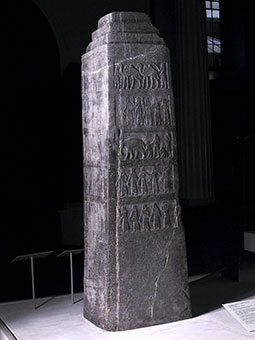
Image 1: The Black Obelisk of Shalmaneser III, carved with scenes celebrating the achievements of the Assyrian king and his chief minister; 825 BC. British Museum, BM 118885 [http://www.britishmuseum.org/research/collection_online/collection_object_details.aspx?objectId=367012&partId=1]. View information and large image on the British Museum's website. © The Trustees of the British Museum.
The Black Obelisk (Image 1) is a monument (or stela TT ) carved from black limestone, which stands just under two metres high. It has four sides, each 45 cm wide. The top is stepped as though shaped like a ziggurat TT with four sloping stages. The significance of this shape is unknown, but it does seem to be standard for Assyrian obelisks TT . The White Obelisk of Assurnasirpal I found by Hormuzd Rassam at Nineveh shares this shape.
The function of obelisks is not certain, but judging from its four faces, and its findspot TT , it is reasonable to conclude that it was designed for public display. The Black Obelisk (Image 1) was erected in a courtyard outside a large building in the centre of Kalhu, now known as the "Central Building", which is thought to be one of the temples listed in Assurnasirpal II's Standard Inscription (1). At the time of the stela's TT erection, Kalhu was the capital of an Assyrian empire torn apart by civil war, so maybe it was intended to remind the king's retinue of the extent of his authority and rule.
Acts of tribute to the Assyrian king
Five scenes wrap around the Obelisk. They each depict tribute TT exacted from a vassal TT , who is named in a cuneiform TT caption. The tribute includes exotic animals such as camels, monkeys, an elephant and a rhinoceros. Assyrian kings often collected exotic animals and plants as an expression of their power. It is thought that the vassals shown here are chosen to demonstrate the geographical bounds of the empire, from east to west. The Black Obelisk also has a longer inscription, which tells of Shalmaneser's achievements in more detail (2).
The five tribute scenes as they wrap around the monument are as follows, from top to bottom:
Scene 1: Shalmaneser receives tribute from Sua of Gilzanu
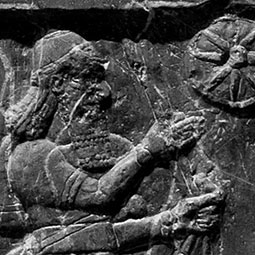
Detail from Scene 1, Side A of the Black Obelisk. Richly dressed king Shalmaneser III holds a bow and stands next to an emblem of the sun god, Šamaš PGP . At Shalmaneser's feet (see large image), a vassal subject named Sua the Gilzanean PGP crouches in a pose of tribute. View high-quality large image of Scene 1 (1.7 MB). © The Trustees of the British Museum.
"I received tribute from Sua the Gilzanean PGP : silver TT , gold TT , tin, bronze TT cauldrons TT , the staffs 'of the king's hand', horses (and) two-humped camels."
- Side A: Shalmaneser, holding a bow, receives "tribute from Sua the Gilzanean". (This event is recorded in Shalmaneser's annals (3)). He faces his field marshal and another official.
- Side B: Two Assyrian officials, a foreign groom and a horse with rich trappings, representing the horses for which Gilzanu PGP was famous.
- Side C: [Indian] Two attendants bring "two-humped (Bactrian) camels" from Gilzanu.
- Side D: Five tribute-bearers with "silver, gold, tin, bronze cauldrons (and) the 'staffs of the king's hand'" from Gilzanu.
View high-quality large image of Scene 1 from the Obelisk (1.7 MB).
Scene 2: Shalmaneser receives tribute from Iaua (Jehu) of the House of Omri (ancient northern Israel)
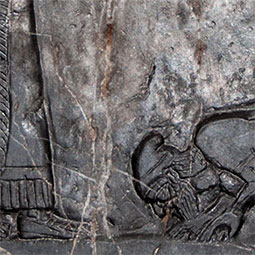
Detail from Scene 2, Side A of the Black Obelisk. A vassal subject named Iaua PGP (known in the Bible as king Jehu of Israel PGP ) crouches in a pose of tribute at king Shalmaneser III's feet. View high-quality large image of Scene 2 (1.7 MB). © The Trustees of the British Museum.
"I received tribute from Iaua, son of Omri: silver, gold, a golden bowl, a golden tureen, golden pails, tin, the staffs 'of the king's hand' and a spear."
- Side A: Shalmaneser, beneath a parasol TT , accepts the "tribute of Iaua PGP of the House of Omri" in 841 BC. This is king Jehu of Israel PGP , who appears in the Bible (2 Kings 9-10).
- Side B: Two Assyrian officials and three tribute-bearers from Israel with "silver, gold ... gold vessels ... tin ...".
- Side C: Five more tribute-bearers from Israel with "a gold bowl, a golden tureen, gold vessels, gold pails, tin, the 'staffs of the king's hand' (and) spears".
- Side D: Five tribute-bearers from Israel with "silver, gold, a gold bowl, a gold tureen, gold vessels, gold pails (and) tin".
View high-quality large image of Scene 2 from the Obelisk (1.7 MB).
Scene 3: A parade of exotic animals from Muṣri
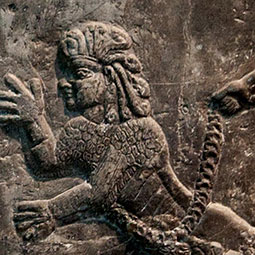
Detail from Scene 3, Side D of the Black Obelisk. A monkey or ape from Muṣri PGP ? This strange-looking humanoid figure, chained by its leg and restrained by a keeper, is described as one of the "female monkeys and apes" brought as tribute to Shalmaneser from the country of Muṣri. View high-quality large image of Scene 3 (1.6 MB). © The Trustees of the British Museum.
"I received tribute from Muṣri: two-humped camels, a water buffalo TT , a rhinoceros, an antelope, female elephants, female monkeys and apes."
- Side A: Attendants bring "tribute from Muṣri: two-humped camels". Muṣri, meaning 'borderland', probably refers to a country far to the east.
- Side B: Exotic animals from Muṣri: "a river-ox [water-buffalo], an [Indian] rhinoceros (and) an antelope". The sculptor seems never to have seen a rhinoceros.
- Side C: "Female [Indian] elephants, female monkeys (and) apes" from Muṣri.
- Side D: More "monkeys" and their keepers from Muṣri. The way the monkeys are carved suggests that the sculptor had not seen them himself. This may not be the case, however. Monkeys were not new sights for the Assyrian court at this time.
View high-quality large image of Scene 3 from the Obelisk (1.6 MB).
Scene 4: Marduk-apla-uṣur the Suhean sends animals and other tribute
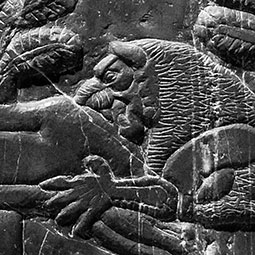
Detail from Scene 4, Side A of the Black Obelisk. A roaring big cat, given as tribute to Shalmaneser III by Marduk-apla-uṣur PGP from Suhu PGP (on the Middle Euphrates). View high-quality large image of Scene 4 (1.7 MB). © The Trustees of the British Museum.
"I received tribute from Marduk-apla-uṣur PGP , the Suhean PGP : silver, gold, pails, ivory TT , spears, byssus TT , garments with multi-coloured trim and linen."
- Side A: Lions and a stag from "Marduk-apla-uṣur PGP the Suhean PGP ", probably for the royal hunting park.
- Side B: Four tribute-bearers from Suhu with "silver, gold... byssus, garments with multi-coloured trim and linen [garments]".
- Side C: Five tribute-bearers with "silver, gold, gold pails, ivory [tusks] (and) spears" from Suhu.
- Side D: Four tribute-bearers with "silver, gold, gold pails, ivory [tusks] (and) spears" from Suhu.
View high-quality large image of Scene 4 from the Obelisk (1.7 MB).
Scene 5: Qarparunda the Patinean sends precious metals, ivory and ebony
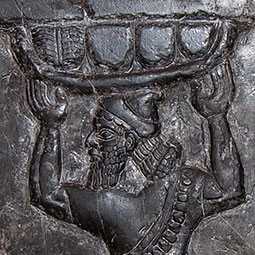
Detail from Scene 5, Side A of the Black Obelisk. A bearded man from Patina PGP carries a large basket or bowl on his head, as tribute for king Shalmaneser III. View high-quality large image of Scene 5 (1.8 MB). © The Trustees of the British Museum.
"I received tribute from Qarparunda PGP the Patinean PGP : silver, gold, tin, bronze compound, bronze cauldrons, ivory and ebony."
- Side A: "Tribute from Qarparunda the Patinean: silver, gold, tin, 'fast' bronze ... ivory [tusks] (and) ebony".
- Side B: Two Assyrian officials introduce three tribute-bearers from Patina PGP .
- Side C: Five tribute-bearers with "gold and silver" vessels and a "bronze cauldron" from Patina.
- Side D: Four tribute-bearers with "gold and silver" vessels and a "bronze cauldron" from Patina.
View high-quality large image of Scene 5 from the Obelisk (1.8 MB).
Content last modified: 18 Dec 2019.
References
- Oates, D. and J. Oates, 2001. Nimrud, An Assyrian Imperial City Revealed, London: British School of Archaeology in Iraq ( free PDF from BISI, 128 MB), pp. 71-73. (Find in text ^)
- Grayson, A.K., 1996. Assyrian Rulers of the Early First Millennium BC II (858-745 BC) (Royal Inscriptions of Mesopotamia. Assyrian Periods. Volume 3), Toronto: University of Toronto Press, pp. 62-71: A.0.102.14 (with detailed bibliography), pp.148-51: A.0.102.87-91. (Find in text ^)
- Grayson, A.K., 1996. Assyrian Rulers of the Early First Millennium BC II (858-745 BC) (Royal Inscriptions of Mesopotamia. Assyrian Periods. Volume 3), Toronto: University of Toronto Press, pp. 32-41: A.0.102.6, I 41. (Find in text ^)
Jonathan Taylor
Jonathan Taylor, 'The Black Obelisk of Shalmaneser III', Nimrud: Materialities of Assyrian Knowledge Production, The Nimrud Project at Oracc.org, 2019 [http://oracc.museum.upenn.edu/nimrud/livesofobjects/blackobelisk/]